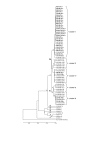Hepatitis B virus genotypes circulating in Brazil: molecular characterization of genotype F isolates
- PMID: 18036224
- PMCID: PMC2231365
- DOI: 10.1186/1471-2180-7-103
Hepatitis B virus genotypes circulating in Brazil: molecular characterization of genotype F isolates
Abstract
Background: Hepatitis B virus (HBV) isolates have been classified in eight genotypes, A to H, which exhibit distinct geographical distributions. Genotypes A, D and F are predominant in Brazil, a country formed by a miscegenated population, where the proportion of individuals from Caucasian, Amerindian and African origins varies by region. Genotype F, which is the most divergent, is considered indigenous to the Americas. A systematic molecular characterization of HBV isolates from different parts of the world would be invaluable in establishing HBV evolutionary origins and dispersion patterns. A large-scale study is needed to map the region-by-region distribution of the HBV genotypes in Brazil.
Results: Genotyping by PCR-RFLP of 303 HBV isolates from HBsAg-positive blood donors showed that at least two of the three genotypes, A, D, and F, co-circulate in each of the five geographic regions of Brazil. No other genotypes were identified. Overall, genotype A was most prevalent (48.5%), and most of these isolates were classified as subgenotype A1 (138/153; 90.2%). Genotype D was the most common genotype in the South (84.2%) and Central (47.6%) regions. The prevalence of genotype F was low (13%) countrywide. Nucleotide sequencing of the S gene and a phylogenetic analysis of 32 HBV genotype F isolates showed that a great majority (28/32; 87.5%) belonged to subgenotype F2, cluster II. The deduced serotype of 31 of 32 F isolates was adw4. The remaining isolate showed a leucine-to-isoleucine substitution at position 127.
Conclusion: The presence of genotypes A, D and F, and the absence of other genotypes in a large cohort of HBV infected individuals may reflect the ethnic origins of the Brazilian population. The high prevalence of isolates from subgenotype A1 (of African origin) indicates that the African influx during the colonial slavery period had a major impact on the circulation of HBV genotype A currently found in Brazil. Although most genotype F isolates belonged to cluster II, the presence of some isolates belonging to clusters I (subgroup Ib) and IV suggests the existence of two or more founder viral populations of genotype F in Brazil.
Figures


Similar articles
-
Clade analysis and surface antigen polymorphism of hepatitis B virus American genotypes.J Med Virol. 2004 Mar;72(3):377-84. doi: 10.1002/jmv.20015. J Med Virol. 2004. PMID: 14748061
-
Molecular and serological characterization of hepatitis B virus genotype A and D infected blood donors in Poland.J Viral Hepat. 2010 Jun;17(6):444-52. doi: 10.1111/j.1365-2893.2009.01192.x. Epub 2009 Sep 25. J Viral Hepat. 2010. PMID: 19780948
-
Phylogeography and evolutionary history of hepatitis B virus genotype F in Brazil.Virol J. 2013 Jul 16;10:236. doi: 10.1186/1743-422X-10-236. Virol J. 2013. PMID: 23855930 Free PMC article.
-
Distribution of HBV genotypes in Latin America.Antivir Ther. 2013;18(3 Pt B):459-65. doi: 10.3851/IMP2599. Epub 2013 Jun 21. Antivir Ther. 2013. PMID: 23792558 Review.
-
Hepatitis B virus genotypes in Brazil: Introduction and dissemination.Infect Genet Evol. 2021 Sep;93:104936. doi: 10.1016/j.meegid.2021.104936. Epub 2021 May 21. Infect Genet Evol. 2021. PMID: 34023512 Review.
Cited by
-
Distribution of hepatitis B virus subgenotype F2a in São Paulo, Brazil.BMC Res Notes. 2013 Oct 21;6:423. doi: 10.1186/1756-0500-6-423. BMC Res Notes. 2013. PMID: 24139701 Free PMC article.
-
Characterization of hepatitis B virus in Amerindian children and mothers from Amazonas State, Colombia.PLoS One. 2017 Oct 10;12(10):e0181643. doi: 10.1371/journal.pone.0181643. eCollection 2017. PLoS One. 2017. PMID: 29016603 Free PMC article.
-
Viral hepatitis in female sex workers using the Respondent-Driven Sampling.Rev Saude Publica. 2017 Jun 26;51:65. doi: 10.1590/S1518-8787.2017051006540. Rev Saude Publica. 2017. PMID: 28678904 Free PMC article.
-
Hepatitis B virus subgenotype A1: evolutionary relationships between Brazilian, African and Asian isolates.PLoS One. 2014 Aug 14;9(8):e105317. doi: 10.1371/journal.pone.0105317. eCollection 2014. PLoS One. 2014. PMID: 25122004 Free PMC article.
-
HBV genotypic variability in Cuba.PLoS One. 2015 Mar 5;10(3):e0118959. doi: 10.1371/journal.pone.0118959. eCollection 2015. PLoS One. 2015. PMID: 25742179 Free PMC article.
References
-
- Norder H, Hammas B, Lee SD, Bile K, Courouce AM, Mushahwar IK, Magnius LO. Genetic relatedness of hepatitis B viral strains of diverse geographical origin and natural variations in the primary structure of the surface antigen. J Gen Virol. 1993;74 ( Pt 7):1341–1348. - PubMed
MeSH terms
Substances
LinkOut - more resources
Full Text Sources
Medical
Miscellaneous

